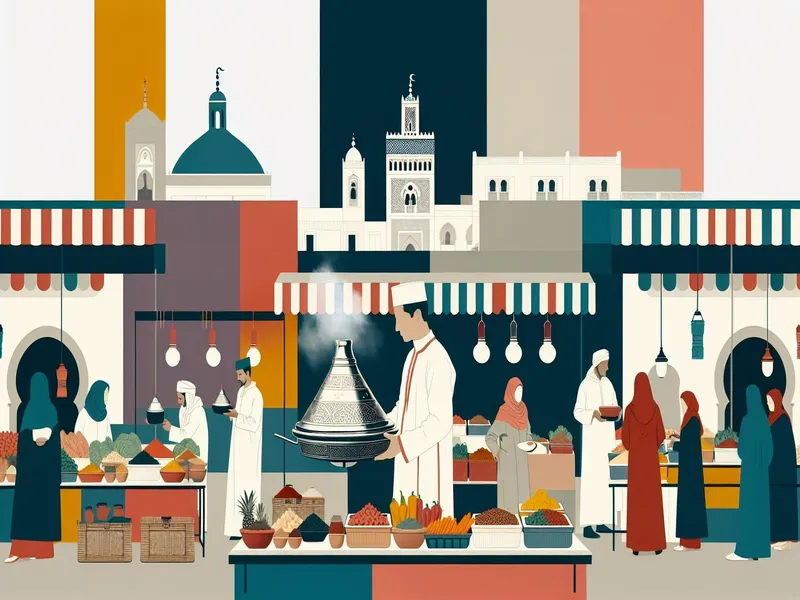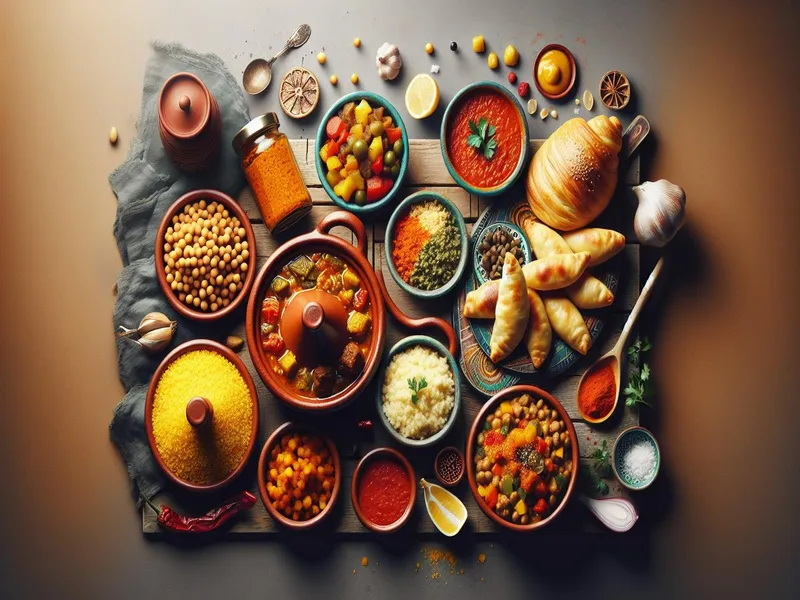
If you’re craving authentic culinary adventures, this region offers vibrant markets, aromatic spices, and age-old recipes that promise to tantalize your taste buds. Whether you’re planning a trip or just daydreaming about exotic flavors, understanding what makes North African cuisine unique will enrich your travel experience.
Ignoring the rich culinary heritage of North Africa means missing out on an essential part of its culture. Without diving into the local food scene, you’ll leave with only half the story. Imagine traveling all that way and not savoring tagine in Morocco or couscous in Tunisia—it’s almost unthinkable! Your travel memories won’t be as vivid without those sensory experiences.
Having explored various corners of North Africa myself, I can assure you there’s nothing quite like it. From bustling souks to serene tea houses, each bite tells a story steeped in history and tradition. Check out our guide on travel activities for more ways to immerse yourself fully.
Whether you’re a foodie adventurer or just curious about new cultures, this guide will cater to your interests. I’ll break down must-try dishes and drinks from different regions so you can plan an unforgettable culinary journey tailored to your palate.
Exploring Culinary Traditions
When you travel to North Africa, diving into the local food scene is a must. Trust me, it’s like opening a treasure chest of flavors and history.
Historical Influences on North African Cuisine
North African cuisine didn’t just pop up overnight; it’s got layers of history baked in. Ancient trade routes brought spices from Asia and grains from Europe. The Berbers, Arabs, French, and Spanish all left their marks too. Imagine eating a Moroccan tagine: you’re not just tasting stew; you’re savoring centuries of cultural fusion.
Key Ingredients and Flavors
You’ll find certain ingredients that define North African cooking:
- Couscous: This staple grain is like rice for us but fluffier.
- Harissa: A spicy chili paste that adds heat to many dishes.
- Preserved Lemons: They give stews a tangy kick.
Culinary Hotspots

North Africa’s food scene is a treasure trove of flavors and experiences. Let’s jump into some must-visit culinary hotspots in this vibrant region.
Morocco: A Feast for the Senses
Morocco’s food is like a sensory overload, in the best way possible. Imagine sitting in Marrakech, surrounded by sizzling street food stalls. Tagines, slow-cooked stews with meat or veggies, are everywhere you look. I remember a time when I tried b’stilla, a flaky pastry filled with pigeon meat and dusted with powdered sugar—it was sweet, savory, and utterly unforgettable. Don’t miss out on mint tea; it’s not just a drink but an experience served with ceremony.
Tunisia: A Mediterranean Delight
Tunisia combines Mediterranean freshness with robust North African spices. Picture yourself lounging by the coast, enjoying fresh seafood that’s grilled to perfection. One dish that stands out is brik, a thin pastry stuffed with egg and tuna—crispy on the outside, gooey inside. During my visit to Tunis, I loved how locals would gather around large platters of couscous topped with lamb and vegetables on Fridays. And if you’re up for something spicy, try harissa; it’s their go-to chili paste.
Egypt: A Blend of Cultures
Egyptian cuisine offers an exciting mix due to its rich history of cultural influences. Walking through Cairo’s bustling streets, you’ll find vendors selling koshari, a comforting mix of rice, pasta, lentils topped with tomato sauce and crispy onions—the ultimate street food! Another gem is molokhia, a green soup made from jute leaves often paired with chicken or rabbit—it’s earthy and deeply flavorful. Once I even had it at a local family’s home—it felt like tasting history itself.
These hotspots offer more than just meals—they’re windows into centuries-old traditions and cultures that make North Africa so fascinating.
Signature Dishes to Try

When you’re exploring North Africa, tasting the local food is like taking a bite out of history. Each dish tells a story, and trust me, these stories are delicious. Let’s jump into some must-try dishes that you can’t miss.
Moroccan Tagine and Couscous
Moroccan cuisine’s crown jewels? Tagine and Couscous. Picture this: tender meat or veggies slow-cooked with spices in a cone-shaped clay pot (that’s the tagine). The result? A savory blend of flavors that’s comforting yet exotic.
And then there’s couscous. These tiny grains of steamed semolina might look simple, but they’re anything but plain. Usually served with a hearty stew or roasted meats, couscous soaks up all those incredible flavors. It’s like your favorite comfort food got an upgrade.
Tunisian Brik and Harissa
Let’s talk Tunisia—specifically, Brik and Harissa. Brik is basically the older cousin of spring rolls—a thin pastry filled with tuna, egg, or even ground lamb, then deep-fried until crispy perfection. Imagine biting into that crunch!
But don’t forget Harissa—Tunisia’s fiery chili paste made from sun-dried peppers and aromatic spices like garlic and coriander seeds. It’s not just spicy; it’s packed with layers of flavor that’ll make your taste buds dance.
Egyptian Koshari and Ful Medames
Egypt offers culinary gems like Koshari and Ful Medames. Koshari is Egypt’s answer to comfort food: rice, lentils, pasta topped with spicy tomato sauce and fried onions—all mixed together in one glorious bowl. Think carbs on carbs—and it’s absolutely divine.
Then there’s Ful Medames—a breakfast staple made from fava beans simmered with olive oil, lemon juice, garlic, and sometimes cumin for an extra kick. Scoop it up with some fresh pita bread for the perfect start to any day.
Unique Beverage Experiences
Exploring North Africa isn’t just about the food; the drinks are equally fascinating. Each beverage offers a taste of local culture and traditions.
Moroccan Mint Tea
When visiting Morocco, you can’t miss Moroccan Mint Tea. It’s not just a drink—it’s a symbol of hospitality. I remember my first sip at a bustling Marrakech market. The tea, sweetened with generous amounts of sugar and infused with fresh mint leaves, was refreshing in the desert heat. Locals pour it from high above the glass to create bubbles on top—a sign that it’s made correctly. Joining in this ritual feels like sharing a piece of Moroccan life.
Tunisian Fig Liquor
Next up, let’s talk about Tunisian Fig Liquor, known as Boukha. This spirit is made from distilled figs and has been part of Tunisian celebrations for centuries. On my visit to Tunisia, I tried Boukha during a family gathering—it’s often served as an aperitif or digestif at social events. It has a smooth texture with a sweet yet slightly spicy kick that lingers on your palate. Imagine sipping this while watching the sunset over ancient ruins—it’s pure magic.
Egyptian Hibiscus Tea
In Egypt, hibiscus tea (locally called Karkade) is a must-try. This vibrant red drink isn’t only delicious but packed with health benefits too—it’s said to lower blood pressure and boost liver health! I first tasted hibiscus tea at a street café in Cairo; its tart flavor was surprisingly refreshing after hours under the hot sun exploring pyramids. Served hot or cold, it’s versatile enough for any season and always brings back memories of Egypt’s rich history.
Embarking on these unique beverage experiences adds another layer to your North African adventure, making every sip unforgettable.
Cooking Classes and Food Tours
Food tours and cooking classes in North Africa offer immersive experiences, letting you jump into the region’s rich culinary traditions. Imagine savoring a Moroccan tagine you made yourself or strolling through a bustling market with a local guide pointing out exotic spices.
Finding Authentic Experiences
Looking for genuine experiences? It’s all about connecting with locals. Market tours are amazing; they let you see how ingredients go from stall to plate. In Marrakesh, I joined a group that took us through Jemaa el-Fnaa Square before our cooking class began. We picked fresh produce and learned about traditional herbs like saffron and cumin.
Cooking schools often have partnerships with local chefs who share family recipes passed down generations. Whether you’re in Tunisia learning to make brik or Egypt mastering koshari, authenticity comes from these personal touches.
Recommendations and Tips
Here are some handy tips:
- Book ahead: Popular classes fill up quickly.
- Ask questions: Get the most out of your experience by engaging with instructors.
- Taste everything: Even if it looks unfamiliar, give it a try—you might discover your new favorite dish!
When I was in Tunisia, our instructor encouraged us to taste harissa straight from the jar. Spicy but delicious! Also, be mindful of cultural etiquette: always use your right hand when eating communal dishes.
Wrapping Up
Exploring North Africa through its food and drink is a journey into the heart of its culture and history. Each dish and drink tells a story of ancient trade routes, diverse influences, and local traditions. From savoring Moroccan tagine to sipping Egyptian hibiscus tea every bite and sip becomes a memorable experience.
Engaging in market tours cooking classes and tasting local specialties offer deeper connections with the region’s culinary heritage. These experiences ensure that your adventure in North Africa is not just about travel but also about understanding and appreciating the rich world of flavors that define this vibrant part of the world.